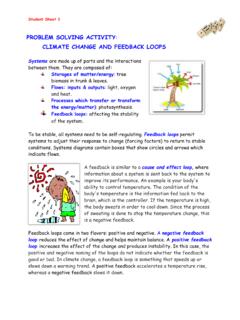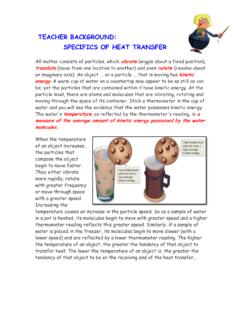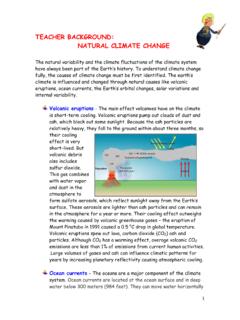Transcription of CRITICAL THINKING ACTIVITY: THE ELECTROMAGNETIC …
1 1 Student Sheet 1 CRITICAL THINKING ACTIVITY: THE ELECTROMAGNETIC SPECTRUM There are many kinds of energy in the universe. The energy given off from the sun is radiant energy, scientifically called ELECTROMAGNETIC radiation. Produced by nuclear reactions at the core of the sun, this energy streams from the surface of the sun in waves of different lengths. The shortest and longest wavelengths are invisible to our eyes, but the medium wavelengths are the visible radiation we call sunlight. Most of the sun s energy is released in these visible wavelengths. All substances have kinetic energy that is expressed by vibrations of their atoms or molecules.
2 The vibrations result in radiation. The ELECTROMAGNETIC (EM) spectrum is a name given to all of the different types of radiation. ELECTROMAGNETIC radiation is energy that spreads out as it travels. Visible light radiation that comes from a lamp in someone s house or radio wave radiation that comes from a radio station are two types of ELECTROMAGNETIC radiation. Other examples of EM radiation are microwaves, infrared and ultraviolet radiation, X-rays and gamma rays. Hotter, more energetic objects and events create higher energy radiation than cool objects. Only extremely hot objects or particles moving at very high speeds can create high-energy radiation like X-rays and gamma rays.
3 2 Student Sheet 2 A common assumption is that radio waves are completely different than X-rays and gamma rays. They are produced in very different ways, and we detect them in different ways. However, radio waves, visible light, X-rays, and all the other parts of the ELECTROMAGNETIC spectrum are fundamentally the same. They are all forms of ELECTROMAGNETIC radiation. All substances give off ELECTROMAGNETIC radiation in the form of ELECTROMAGNETIC waves. The motion of different waves enables scientists to classify them into different parts of the ELECTROMAGNETIC spectrum. Wave Motion Wave (a): Longer Wavelength Lower Frequency Wave (b): Shorter Wavelength Higher Frequency Waves are measured by their length (wavelength) in meters.
4 They are also measured by the number of waves that pass a point in space each second or their frequency. ELECTROMAGNETIC waves vary in their lengths from very short waves (billionths of a centimeter) to very long waves (hundreds of kilometers). It is important to remember that the various kinds of ELECTROMAGNETIC radiation differ only in their wavelength and frequency. They are alike in all other respects. However some ELECTROMAGNETIC radiation is strong enough to penetrate certain substances (skin, for example) while other forms are not. Similarly, some ELECTROMAGNETIC radiation is capable of causing damage to molecules and cells. You may know that people are cautioned to limit their time in the sun for this reason, since exposure to ultraviolet radiation can cause skin cancer.
5 3 Student Sheet 3 PROPERTIES OF ELECTROMAGNETIC RADIATION 1-1)1-2) 1-3) 1-4)1-5)1-6) 4 Student Sheet 4 RESEARCH GUIDE GROUP 1: RADIO WAVE RADIATION 1. Define radio wave radiation: 2. Describe where radio waves are found on the EMS compared to the other six forms of radiation. In your description, compare and contrast it with wavelength, frequency and energy with those of other regions of the EMS. 3. Are there human health risks from exposure (or overexposure) to radio wave radiation? If so: Describe the main risk(s). Describe common sources of exposure (or overexposure). Describe a technology, device, or behavior that can be used for protection, or to decrease exposure.
6 4. Describe how radio waves are used in cell phone wireless communication technology. (Description ) (Drawing ) 5 Student Sheet 5 RESEARCH GUIDE GROUP 2: MICROWAVE RADIATION 1. Define microwave radiation: 2. Describe where microwaves are found on the EMS compared to the other six forms of radiation. In your description, compare and contrast its wavelength, frequency and energy with those of other regions of the EMS. 3. Are there human health risks from exposure (or overexposure) to microwaves? If so: Describe the main risk(s). Describe common sources of exposure (or overexposure). Describe a technology, device, or behavior that can be used for protection or to decrease exposure.
7 4. Describe how a microwave oven uses microwaves to quickly heat food. (Description ) (Drawing ) 6 Student Sheet 6 RESEARCH GUIDE GROUP 3:INFRARED RADIATION 1. Define infrared radiation: 2. Describe where infrared is found on the EMS compared to the other six forms of radiation. In your description, compare and contrast its wavelength, frequency and energy with those of other regions of the EMS: 2. Are there human health risks from exposure (or overexposure) to infrared radiation? If so: Describe the main risk(s). Describe common sources of exposure (or overexposure). Describe a technology, device, or behavior that can be used for protection or to decrease exposure.
8 4. Describe how infrared technology can be used to enable people to see in the dark (Description ) (Drawing ) 7 Student Sheet 7 RESEARCH GUIDE GROUP 4: VISIBLE LIGHT RADIATION 1. Define visible light radiation: 2. Describe where visible light is found on the EMS compared to the other six forms of radiation. In your description, compare and contrast its wavelength, frequency and energy with those of other regions of the EMS. 3. Are there human health risks from exposure (or overexposure) to visible light? If so: Describe the main risk(s). Describe common sources of exposure (or overexposure). Describe a technology, device, or behavior that can be used for protection, or to decrease exposure.
9 3. Describe how visible light is used with solar photovoltaic panels to produce electricity. (Description ) (Drawing ) 8 Student Sheet 8 RESEARCH GUIDE GROUP 5: ULTRAVIOLET RADIATION 1. Define ultraviolet radiation: 2. Describe where ultraviolet is found on the EMS compared to the other six forms of radiation. In your description, compare and contrast its wavelength, frequency and energy with those of other regions of the EMS. 3. Are there human health risks from exposure (or overexposure) to ultraviolet radiation? If so: Describe the main risk(s). Describe common sources of exposure (or overexposure).
10 Describe a technology, device, or behavior that can be used for protection, or to decrease exposure. 4. Describe how ultraviolet radiation is used in tanning bed technology. (Description ) (Drawing ) 9 Student Sheet 8 RESEARCH GUIDE GROUP 6: X-RADIATION 1. Define X-radiation: 2. Describe where X-rays are found on the EMS compared to the other six forms of radiation. In your description, compare and contrast its wavelength, frequency and energy with those of other regions of the EMS. 3. Are there human health risks from exposure (or overexposure) to X- rays? If so: Describe the main risk(s). Describe common sources of exposure (or overexposure).














